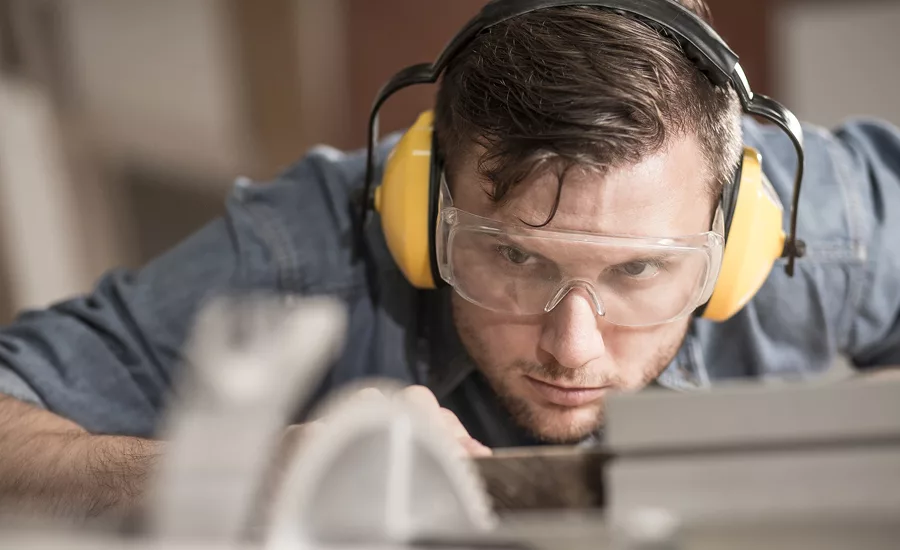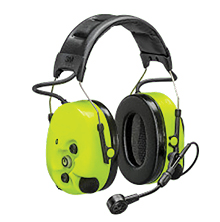Guest Column
Obstructed Communication in a Construction Zone
An inability to communicate with team members in an active construction zone is fraught with peril

According to statistics from the U.S. Department of Labor’s Occupational Safety and Health Administration, workplace accidents — including incidents that result in death — happen frequently. In 2019, 5333 workers died on the job, with an average of 15 daily deaths. While worker deaths and accidents have declined since the 1970s, careless mistakes and errors contribute to these preventable incidents. Keeping your ears open may mean the difference between life and death.
— Image courtesy of NDCA
Working on a construction site is akin to keeping your head on a swivel, looking for anything that may invade your personal space while ensuring lines of communication remain clear. The sounds of a construction site might be symphonic, but it can be perilous if you cannot hear properly.
According to statistics from the U.S. Department of Labor’s Occupational Safety and Health Administration, construction site accidents — including incidents that result in death — happen frequently.
In 2019, 5333 workers died on the job, with an average of 15 daily deaths. While worker deaths and accidents have declined since the 1970s, careless mistakes and errors contribute to these preventable incidents. Keeping your ears open may mean the difference between life and death.
On an active construction site or voluminous supply warehouse with constantly running equipment, noise pollution creates difficulties in communication. So, what is one to do? Here are a few tips:
Address Headphone Use
Headphones with noise cancellation are a sought-after item for holidays and birthday gifts. After all, who doesn’t want a pair of headphones that can drown out the loud noises that pollute our everyday lives?
However, these headphones can pose a hazard on a job site if not used properly, and this is where the significance of selecting the right hearing protection comes into play. While headphones that minimize noise exposure at the job site can mitigate hearing damage, they can also hinder important communication channels.
You may be able to see a co-worker trying to get your attention, but what if that co-worker’s yelling is unable to penetrate the sounds of your jam session?
Clearly Communicate Safety Regulations
Perhaps you’ve heard the old saying, “Safety regulations are written in blood,” on job sites, as said by retired US Coast Guard Capt. Kyle McAvoy. Fatalities and accidents tend to lay bare our worst on-the-job habits.
Federal and state safety regulations are available via various government websites. But, these safety regulations should be handy at any site. Whether the rules and regulations are stored in the on-site office or saved on someone’s smartphone, they must be available.
Considering the amount of frenetic, labor-intensive work on a construction site or warehouse, clearly communicating safety regulations with workers will prevent injury or death.
Dangers on the Site
Construction site managers may be up to speed on the potential risks of injury or death on the site, but workers tend to be more flippant. Managers must enforce the rules, and workers should be aware of any risks.
Communicating risks clearly and creating understanding is crucial to preventing site issues. What may be a boring information meeting for some employees may save a life or prevent debilitating injury.
Construction company leaders' job is to exquisitely and plainly communicate the dangers on any job site.
Here are a few things to keep in mind on the site:
Falling Objects
Falling objects on a site can cause myriad issues, including head injuries. We wear hard hats for this reason. But, being able to communicate about the potential for falling objects is paramount for the literal boots on the ground.
Poor ‘hazard’ communication may leave workers exposed. Workers must be briefed on wearing proper safety equipment and what to do if an object (like a tool or a piece of material) begins to fall from a great height.
Falls
According to statistics provided by the National Safety Council, falls are the number one killer of workers on a construction site. In 2020, 805 workers died from falls. These falls normally include heights on upper levels, scaffolds, roofs, and ladders, but 136 deaths were on the same level in 2020. Anything is possible on-site without proper communication.
Workers deal with heights every day at construction sites worldwide, and while this is not new, what is new is being able to use on-site resources and safety equipment to help prevent injuries.
Tool-related Injuries
It doesn’t take much to show you how easy it can be to injure yourself with a tool. Cracked and bloody fingernails, cuts, bruises, and more are hallmark injuries for construction workers.
Workers using heavy-duty equipment with the possibility of severe injury should always keep lines of communication open. A saw may look like a fun tool, but it can be harmful in inexperienced hands.
Whatever ways you use communication techniques on a construction site, having clear lines of communication remains life-saving in many circumstances. Having workers maintain communication even during the loudest construction noises can make a difference.
At the end of the day, communication and over-communication on a job site can prevent a valuable employee from being hospitalized or worse. Communication is also a team effort, pulling in the expertise of every person on the site. Whatever it takes, the folks on site must have safe and effective avenues to speak up, prevent injuries, and ultimately save lives.
Looking for a reprint of this article?
From high-res PDFs to custom plaques, order your copy today!







